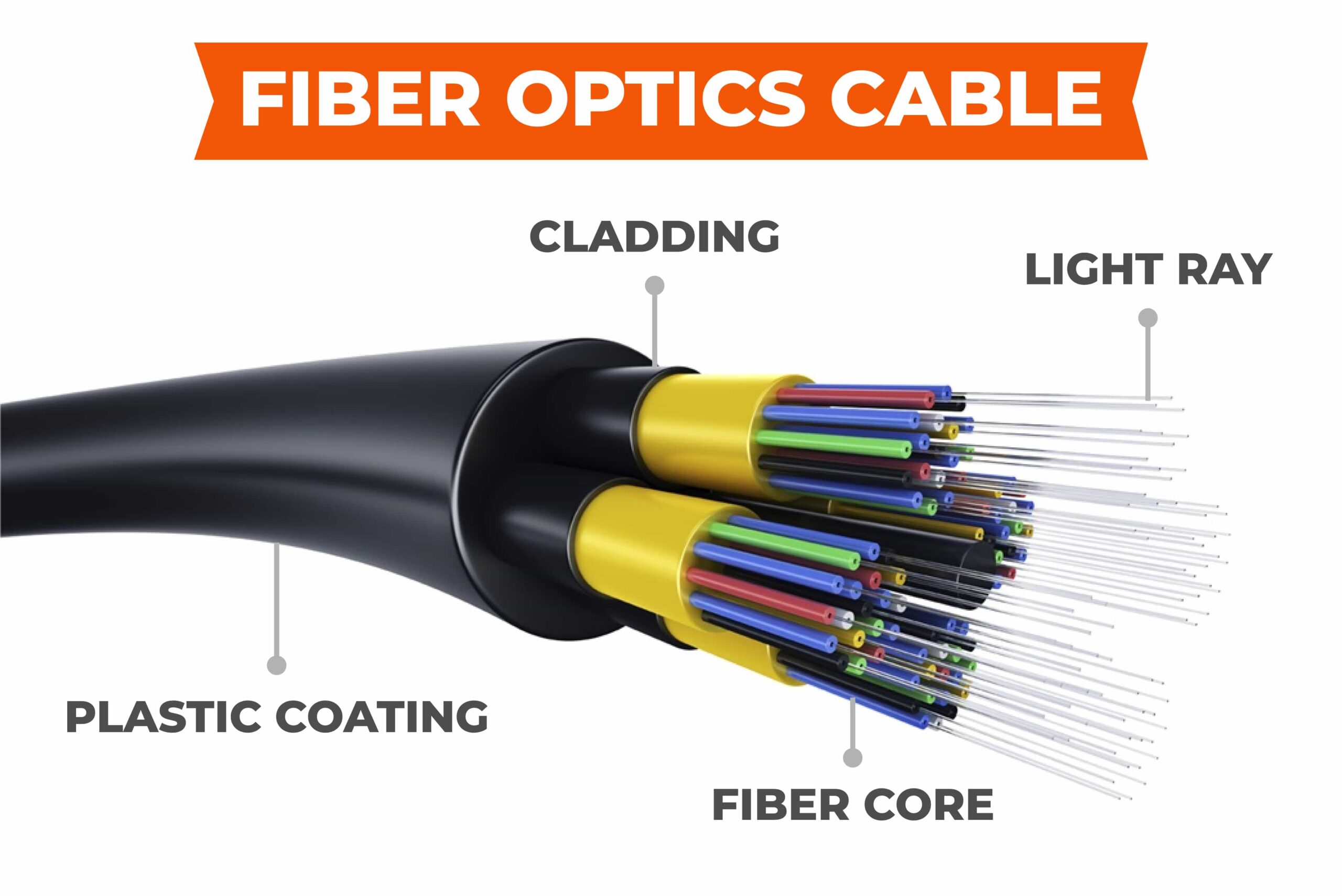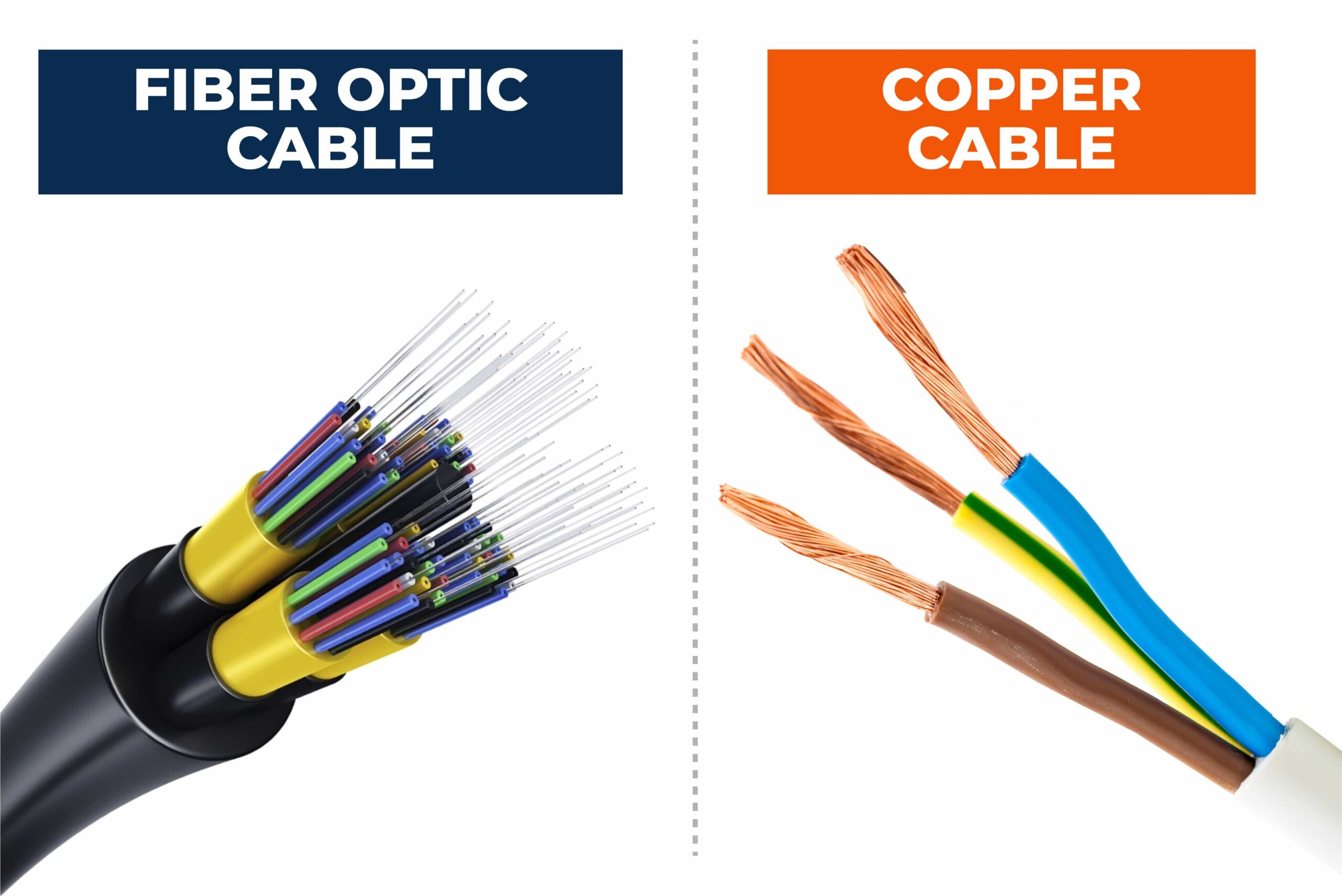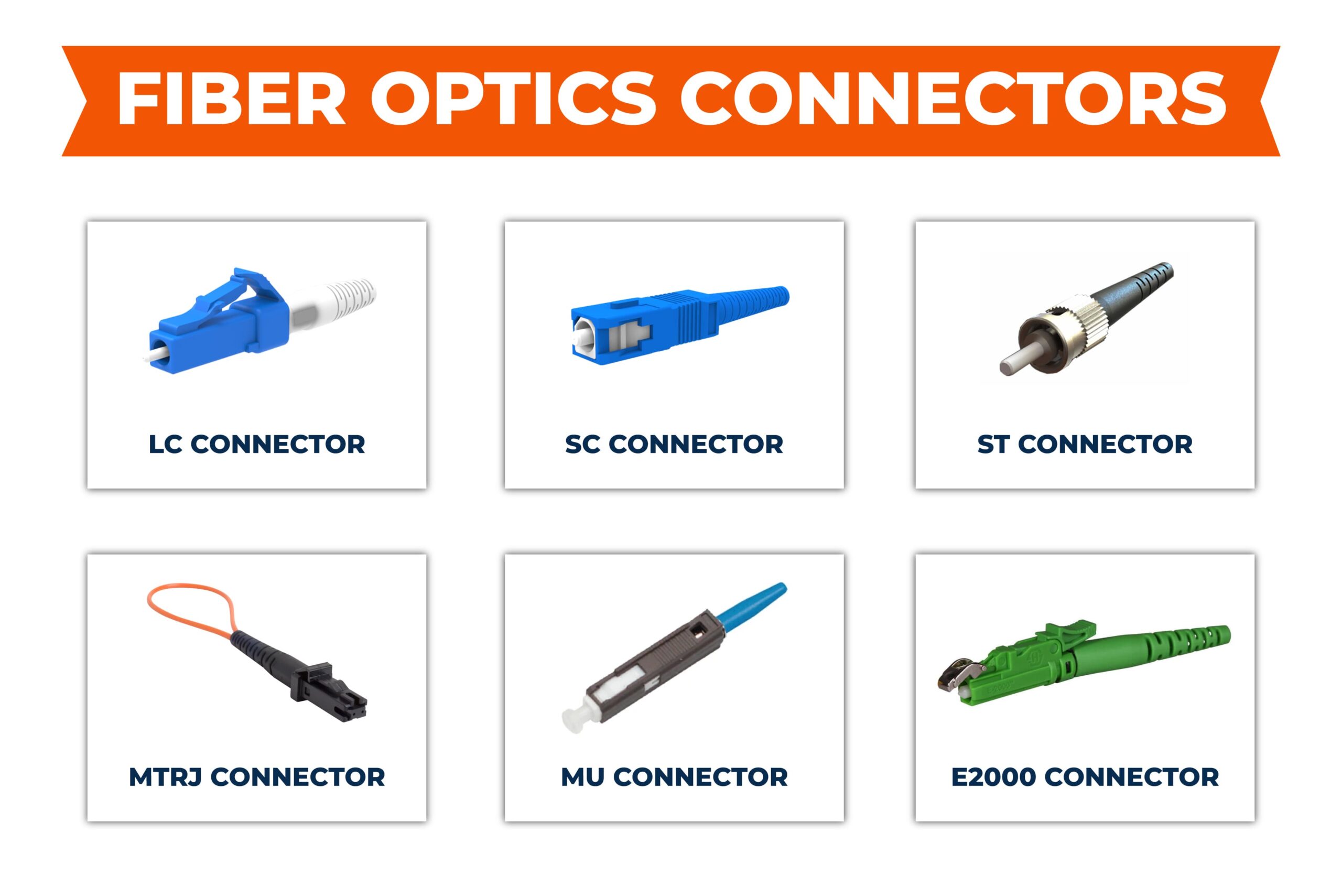M. Waleed Sheikh2025-02-10T13:53:41+00:00
Table of Contents
ToggleWhat is Fiber Optic Cable?
Fiber optics is replacing copper wire networks in the telecommunications industry as it offers significant benefits over conventional cables. It uses thin strands of pure glass as a waveguide for light transmission over long distances through total internal reflection. The cable has two layers: the core carrying the light signal and the cladding with a lower refractive index, causing total internal reflection. Most fibers operate in duplex pairs, but it’s possible to send both signals over a single strand.
Two main fiber optic cable types are;
- Single Mode Fiber (SMF) with a narrow core for a single light mode.
- Multi-Mode Fiber (MMF) with a broader core for multiple light modes.
Each type of fiber optic cable has its own pros and cons.
How Fiber Optic Cables Work?
The fiber optic cable is made up of glass strands that are very similar to human hairs in thickness. These hairs, like glass strands, collectively make a fiber optics cable. These strands create a path of light through the core. The core is encased in another layer of glass that is called cladding. The cladding helps the fiber optics to reduce signal loss.
Single-mode and multi-mode optical fiber cables are the two main varieties. Multi-mode optical fiber cables employ LEDs instead of lasers to produce light, whereas single-mode fiber uses incredibly thin glass strands.
Wave Division Multiplexing transmits multiple communication streams through a single optical fiber by combining (multiplexing) and later separating (de-multiplexing) light signals at different wavelengths to maximize data traffic capacity in single-mode optical fiber networks. Each wavelength carries its independent communication stream, effectively increasing the data-carrying capacity of the fiber strand. Wave Division Multiplexing WDM offers significant improvements in network efficiency and performance.
Why Use Optic Fiber Cable?
Optic fiber cables are preferred over traditional copper cables for several technical reasons:
- Fiber optics offer much higher bandwidth capabilities, enabling faster data transmission and supporting high-definition multimedia content.
- Light signals in optical fibers experience minimal attenuation over long distances, allowing data to travel farther without signal boosters.
- Fiber optic cables have immunity to electromagnetic and radio-frequency interference, ensuring stable and reliable data transmission.
- Optical fibers are lighter and thinner than copper cables, making fiber optic cable installation and maintenance more manageable and cost-effective.
- Fiber optics provide increased data security since they do not emit electromagnetic signals that can be intercepted.
- Fiber optic cables can transmit data without any loss over massive distances compared to copper cables.
- Fiber optic cables do not conduct electricity, reducing the risk of electrical hazards.
- Fiber optics are adaptable to future technologies and higher data demands, making them a future-proof investment.
- Fiber optics can be used in various applications, from telecommunications and internet services to medical imaging and industrial networking.
- Fiber optic cables are unaffected by environmental factors like temperature, humidity, or corrosive substances, ensuring consistent performance in challenging conditions.
Design

A fiber optic cable has a core made up of optically pure glass or plastic, which carries the light signals. Surrounding the core is the cladding, a layer with a lower refractive index that keeps the light within the core through total internal reflection. A buffer coating protects the core and cladding, and strength members (e.g., aramid fibers) provide tensile strength. The outer jacket adds further mechanical protection, often made of polyethylene or PVC. Connectors are used to attach the cable to devices or other cables, ensuring precise light transmission. Different fiber optic cable types, such as Single Mode Fiber (SMF) and Multi-Mode Fiber (MMF), cater to specific applications. Fiber optic cable designs vary for indoor, outdoor, aerial, or underwater fiber optic cable installation to suit different environments and requirements.
Reliability and Quality
Optical fibers are inherently strong, but their strength can be compromised by microscopic surface flaws that occur during the manufacturing process. These flaws and external stresses during handling, cabling, and installation can lead to strength degradation and fiber failure. Three main scenarios contribute to flaw growth and degradation: dynamic fatigue, static fatigue, and zero-stress aging.
To ensure the reliability and quality of optical fibers, industry standards like Telcordia GR-20 (Generic Requirements for Optical Fiber and Optical Fiber Cable) have been established. These criteria focus on protecting optical fibers in various operating conditions, particularly outside plant (OSP) environments. For indoor applications, similar criteria are outlined in Telcordia GR-409 (Generic Requirements for Indoor Fiber Optic Cable).
These standards play a vital role in maintaining the performance and longevity of fiber optic cables, considering the stresses and environmental conditions they may encounter during their lifecycle. Adhering to these quality criteria helps to minimize the risk of strength degradation and ensures the reliable operation of fiber optic systems.
Advantages of Fiber Optic Cables

Fiber optic cables offer numerous advantages over traditional copper cables in data transmission and communication.
- One of their key benefits is their high bandwidth capacity, enabling the transmission of large volumes of data at breakneck speeds.
- Unlike copper cables, fiber optics cables experience minimal signal loss over long distances, ensuring reliable data transmission without signal boosters.
- Fiber optics cables are immune to electromagnetic interference, making them highly reliable in environments with electrical noise.
- Fiber optic cables also provide enhanced data security, as they do not emit electromagnetic signals that can be intercepted, ensuring the privacy of transmitted information.
- Moreover, Fiber optic cables are lightweight and thin, facilitating easy installation and management.
- Due to their low latency, these cables are ideal for long-distance transmissions and real-time applications.
- Fibre optic cables are resistant to environmental factors such as temperature changes and moisture, ensuring consistent performance in various conditions. With their durability and low maintenance requirements, fiber optics present a long-lasting and cost-effective solution for high-speed data transmission.
- Due to their adaptability to future technologies, fiber optic cables are a reliable and future-proof investment for any communication network.
What is a Fiber Optic Network?
A fiber optic network is a type of telecommunication network that utilizes fiber optic cables to transmit data and information at high speeds. These cables are optically pure glass or plastic and use light pulses to carry data over long distances with minimal signal loss.
There are multiple types of fiber optic cable networks, each offering varying levels of fiber connectivity to end-users:
- Fiber to the Home (FTTH) or Fiber to the Premises (FTTP): In this type of network, optical fiber cables are directly connected to houses, apartment buildings, or businesses, providing a 100% fiber optic connection. It offers the highest speed and reliability.
- Fiber to the Curb (FTTC): In this network, optical fiber cables run to the curb near homes and businesses, but the signals are carried the rest of the way using copper cables. It offers a partial fiber connection.
- Fiber to the Building (FTTB): In this setup, fiber cables run to a point on a shared property, and another cabling, such as copper cables, connects to offices or other spaces within the building.
Fibre optic networks provide faster and more reliable internet connections than traditional copper-based networks. They offer higher bandwidth, lower latency, and immunity to electromagnetic interference, making them the preferred choice for modern data-intensive applications and services. The increasing deployment of fiber optic networks is revolutionizing how we access and transmit information, enabling a more connected and efficient world.
What are Fiber Networking Connectors?

Fiber networking connectors are devices used to join or terminate fiber optic cables. They ensure the accurate alignment of fiber cores for reliable data transmission. Common fiber optic cable types include SC, LC, ST, FC, MPO/MTP, SMA, and MT-RJ, each suited for specific applications and cable types. Proper connectors are essential for efficient fiber optic network performance.
Installing fiber optic cable in your home can bring high-speed internet and reliable connectivity. If you’re looking for a reliable fiber optics installer, Talk To Us Now and get a free expert consultation.
FAQs
Fiber optic cables are used for high-speed data transmission in telecommunications, internet connections, data centers, and networking. They enable fast and reliable communication by transmitting data as light pulses through thin strands of glass or plastic. Fiber optics are also used in medical imaging, industrial applications, and broadcasting for their high bandwidth and immunity to electromagnetic interference.
The main essential components of a fiber optic cable are as follows:
- Core: The innermost part of the fiber optic cable, the core is a thin strand of optically pure glass or plastic through which light signals travel.
- Cladding: Surrounding the core is the cladding, which is a layer of glass or plastic with a lower refractive index than the core. The cladding’s purpose is to keep the light within the core through total internal reflection.
- Buffer Coating: A protective layer of plastic, known as the buffer coating, is applied around the cladding to shield the delicate core and cladding from external damage.
These three components work together to ensure efficient light transmission through the fiber optic cable, making it a reliable and essential tool for high-speed data transmission and communication.
The two main types of fiber optic cable are Single Mode Fiber (SMF) and Multi-Mode Fiber (MMF). SMF has a small core diameter and is used for long-distance applications, while MMF has a larger core diameter for shorter distances and high-bandwidth connections.
Fiber optic internet is faster than cable internet. While cable internet typically supports speeds of around 1,000 Mbps (megabits per second), fiber optic internet can provide speeds of up to 2,000 Mbps or more. This means that with fiber optic internet, you can download a 2 hour HD movie much faster than cable internet. At 1,000 Mbps, it takes about 32 seconds to download the movie, while at 2,000 Mbps, it only takes approximately 17 seconds.
Fiber optic internet generally offers superior speed and reliability compared to cable internet, but it may come at a higher cost. Whether fiber optic is considered “better” will depend on the individual’s priorities, budget, and availability of fiber optic infrastructure in their area.

